Nippon News - Volume 2 Issue 4

With his time in Japan running short, Scott wanted to see one of the icons of Japan, a Sumo Wrestler. There is a big 15-day tournament here beginning this week to determine the national champion of Sumo, but it only began the day after Scott left. So, a visit to a Sumo Heya was in order to watch the men prepare for their big test. A Heya is sort of like a boarding school for wrestlers, but it also serves as a gym, a recreation club, and even a family to the wrestlers, who live, eat and work out there year round. The idea behind Sumo is simple; push or throw an opponant out of a small cirle. However, there is skill, strength and much tradition involved in this, and Sumo Wrestlers are celebrities and National Heros in Japan.
Sumo is an old, very feudal, and extremely hierarchial organization. There are some 54 Heya stables; all of them in Tokyo. The Heya is typically run by a retired wrestler, and has a rigid, internal pecking order not always apparant to Western eyes. Around 8 am the older of the wrestlers, (identifiable by their white cotton belts), arrive and start training by warming up. Then there is a variety of training bouts, in which a single man might take on a series of others, or there might be individual matches set up to train and test oneself. By 10:30 this group will then hit the showers and then eat their first meal of the day. The lessor-ranked wrestlers follow the elite group with their training session, and are required to eat their meals according to their ranks. The junior Sumos also serve as personal valets to the higher ranks. This includes getting clothes, bringing food and drink, and even massaging the champions if required.
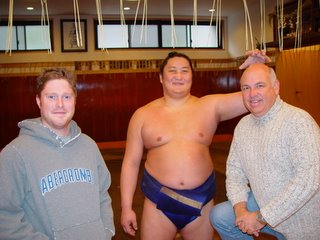
Sumo matches are full of tradition and meaning, and we have tickets to such a day's events in the prestigious New Year Grand Sumo Tournament tournament so I will report further on the proceedings in a later edition. Here is a photo of Scott and Jay with a wrestler in the elite rank, who seems particulary interested in Jay's head, for some obscure reason. Meanwhile, Scott was then off to Narita Airport and is now safely back home, and back to work in snowbound Ottawa.
Later on in the week a day trip to the Obidia and Palettetown districts was in order, so we were eager to see what these areas had in store for us. Obidia means 'platform' in Japanese, and, indeed, it is an artificial island constructed in the Bay of Tokyo, just offshore from the downtown. The original island came about following the arrival of Commodore Matthew Perry and his Black Ships in 1854. Perry, an American, had been sent in a show of force to convince the Japanese that they must open their country to international trade; they had been isolationist for centuries and up to that point had only allowed the Dutch to trade from a single island offshore from Nagasaki, at the southern end of the major Japanese Islands. Given the dramatic nature of this appearance of a foreign force in their capital, the Japanese wanted to improve their defenses, and thus built an aritificial island in the bay on which to mount cannon and construct a fort. Enlarged ever since, the land now serves as a major entertainment and cultural centre, as well as contains some major shipping and receiving facitilites for ships and cargo vessels.

Taking the subway downtown, we transferred to a monorail for the trip over the Rainbow Bridge, which connects the mainland with the islands in the bay. The monorail trip was a little unsettling when, upon close inspection, I discovered that the two guy sitting in front were fellow passengers! There was NOBODY DRIVING THIS THING!! The monorail was completely automated.
The whole area is somewhat evocative of downtown New York, no doubt helped along considerably by the fact that there is a replica of the Statue of Liberty standing in the harbour! The Japanese love most things American; (MacDonald's, Elvis Presley, Rock and Roll, films, and Frank Sinatara), so it is little wonder that they readily adopt much of the cultural flavour of the States, but give it their own, personal twist. As for Canadians, they think of us as relatively harmless, good-natured cousins of the Americans. They love our natural beautiy and vast, open spaces, which is a favourite vaction spot since it is viewed as being cleaner and safer than in the United States. The image of Canada is used to sell products locally; witness Whistler Water (fresh from the glacier), and state-of-the-art High Definition TVs in the Sony Tower feature vistas shot in Whistler, Banff and Vancouver. The tower barely visible mid-span is the Tokyo Tower; a 1950s knockoff of the Eifle Tower. [Above - The Rainbow Bridge and Downtown Tokyo]
Palettetown has a concentration of recreation spots, and on the way in I saw Aqua Park, a R
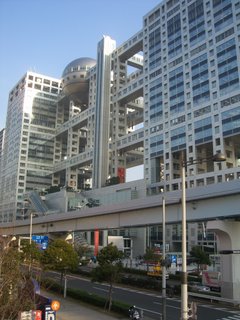 ecreation Mall, a Maritime Museum that was constructed in the shape of a land-locked ship, and many other large buildings that no doubt held other undiscovered treasures. Meanwhile, our first stop was to the corporate offices of Fugi TV; a unique, open concept, steel building featuring a huge ball of titanium mounted on top, which contains a viewing gallary and display area. There were all kinds of museums and theatres available for viewing within the structure, but we opted to take in the panorama from the top and followed this by a tour of the TV studios. Being quite high and facing downtown, the view was excellent, and gave us a great overview of the area. Inside the big ball and accompanying display areas were a variety of things to see and do, including some spectacular set-costumes from a tradition
ecreation Mall, a Maritime Museum that was constructed in the shape of a land-locked ship, and many other large buildings that no doubt held other undiscovered treasures. Meanwhile, our first stop was to the corporate offices of Fugi TV; a unique, open concept, steel building featuring a huge ball of titanium mounted on top, which contains a viewing gallary and display area. There were all kinds of museums and theatres available for viewing within the structure, but we opted to take in the panorama from the top and followed this by a tour of the TV studios. Being quite high and facing downtown, the view was excellent, and gave us a great overview of the area. Inside the big ball and accompanying display areas were a variety of things to see and do, including some spectacular set-costumes from a tradition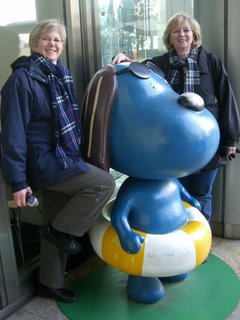 al Japanese play, and the ever-present Fuji TV symbol; a kind of a blue, Snoopy character.
al Japanese play, and the ever-present Fuji TV symbol; a kind of a blue, Snoopy character.Elsewhere, there was a studio tour avalable, which had a sort of Wall of Fame containing photos and signatures of stars, (both stuffed and real), mock sets where one could pose for photographs with some of their favourite TV characters, a chance to appear on live TV beamed in-house, a view of actual studio sets in operation, including one that took touring groups as participants in something resembling the Reach For The Top gameshow, and the inevitable restaurants, souviner shops and the like. Not having had exposure to local programming, (and not understanding it, anyway) we gaijin could only look on whil
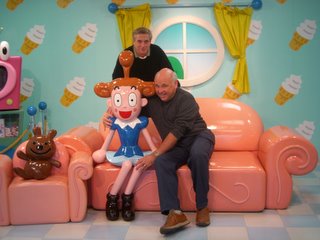 e kids of all ages admired their heros and played on the sets of some of their favourite shows. Us, posing with, (molesting?), a local star on the set.
e kids of all ages admired their heros and played on the sets of some of their favourite shows. Us, posing with, (molesting?), a local star on the set.Next we were off to the Venus Mall, which is an upscale 'themed mall' nearby. (Editorial Comment; I am pretty sure that this was supposed to be the Venice Mall, but, what the Hay - Close Enough!] The mall interior represents scenes from Italy, and it even features a Casino, the first and only one I have seen in Japan! There was no expense spared to outfit the mall, and t
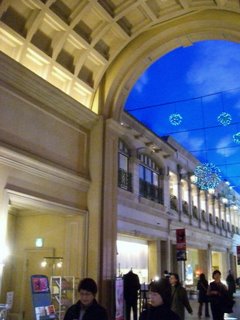 he local advice is to avoid the place on weekends since it gets very crowded. It is such an attraction in itself that there were major tour groups stampeding through while we were there. (Vegas, anyone?)
he local advice is to avoid the place on weekends since it gets very crowded. It is such an attraction in itself that there were major tour groups stampeding through while we were there. (Vegas, anyone?)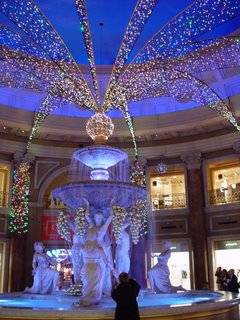
From there a short catwalk stroll took us to the main showroom for Toyota. This was part sales office, part showcase, part amusement park. It was a real, live car dealership selling cars, but it also contained displays of emerging hydrogen fuel-cell technology, concept cars, items from Toyota Formula One racing teams, and every available automobile and sport utility they make. To top it off were virtual rides in cars of various shapes and sizes. There was even a pedal-car race-track for the kiddies to work off some of their suppressed aggression.
Want to take a real car for a spin? No problem! You could book a ride in the parking lot downstairs, where a closed-circuit course was laid out. As for us, we took a mini-car (suitably painted up in a Pac Man theme) on an indoor course that toured the displ
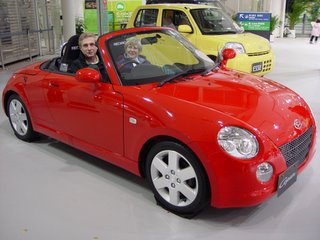 ay floor, went down to the first floor where y
ay floor, went down to the first floor where y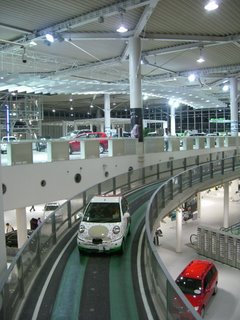 ou went by the maintenance area, along the outside of the building to the closed-circuit driving course, and then back inside the building to the starting point. Now try that in North America!
ou went by the maintenance area, along the outside of the building to the closed-circuit driving course, and then back inside the building to the starting point. Now try that in North America!The little red sportscar (above) is a domestic Japanese model and can be yours for only $17,000 CDN, all taxes and charges included. The only downside is that it has an engine with a displacement of only 650 cc's, and a three speed automatic transmission; it's 0-to-60 is measured in hours! Only thing is, while English names appear to be quite 'chic', (is that English?), the selection seems a bit 'Off' to me. What do you think of car names like: Vibrator, Convoy, Sideswipe, Slash, Prancer, or Groper - (is that supposed to be Grouper?). But, then again, the Japanese leave themselves wide open with an airline named Air Do (nice Air Do ya got there!), which inevitably gets corruped to Air Do Do!!
And, just to top it off, the corporate symbol for Air Do Do is a Penquin, which we all know, CANNOT FLY! Who thought that one up! (Had to be the same crew that represents the Ottawa Senators hockey team visually by a CENTURION, (not a Senator), and named the stadium and the local road after a PALLADIUM, which is the GREEK name for what is supposed to be a Roman COLLESIUM!
After poking, proding and trying out all the sports cars, (I particularily liked the $80,000 Lexus hot-rod), we walked across another catwalk to catch a bite to eat and then on to the big Ferris Wheel. This is one of the dominating sites in the a
 rea; it is some 450 feet high, and when built in 1999 it was the largest in the world. The Japanese love their Ferris Wheels, on the trip down to Hiroshima and Kyoto a few weeks ago I noted that every major city on the way had their own Ferris Wheel. There are several of them here in Tokyo, including at the Disney Park, and another major amusement centre right across a river from that park. By now it was dark, and we were treated to the sights of Toyko at night.
rea; it is some 450 feet high, and when built in 1999 it was the largest in the world. The Japanese love their Ferris Wheels, on the trip down to Hiroshima and Kyoto a few weeks ago I noted that every major city on the way had their own Ferris Wheel. There are several of them here in Tokyo, including at the Disney Park, and another major amusement centre right across a river from that park. By now it was dark, and we were treated to the sights of Toyko at night.Then, on the way home we stopped by a exhibition of industrial design, which featured such diverse things as running shoes that folded into little balls, new designs for househould gadjets, a variety of chairs that you could try
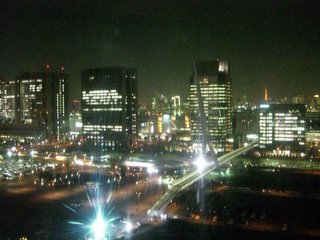 (each of which had one critical flaw engineered into it - too soft, the back kept reclining, the angles too steep, the porportions off, etc.), and even displays of innovative automobile dashes include HUD displays featuring night-vision technology. In totality, this was all a unique experience, and it gives an insight into another side of the Japanese; they absolutely love technology while having a good time!
(each of which had one critical flaw engineered into it - too soft, the back kept reclining, the angles too steep, the porportions off, etc.), and even displays of innovative automobile dashes include HUD displays featuring night-vision technology. In totality, this was all a unique experience, and it gives an insight into another side of the Japanese; they absolutely love technology while having a good time!Elsewhere, the news in Japan centers on the weather; it has been the coldest winter in 60 years and the West Coast is suffering badly. It has already received three times the normal annual snowfall, and train, aircraft and automobile traffic have suffered. In the latest storm to hit the coast more than 60 people died. Here in Tokyo there has been no snow, but it is around 5 - 7 degrees daily; colder than normal. The second major story has to do with the faking of earthquake data on major high-rise buildings. Some of the newest buildings have only 1/3 of the legislated reinforcing required in order to cut costs. Japan is at the intersection of 4 major techtonic plates, and Tokyo is right at the heart of it. The city receives a measureable tremor on average once a day; although most are not detectable other than by sensitive measuring instruments. Personally, I have only felt two tremors since arriving. However, with the 1923 earthquake still in living memory, the city is understandably focused on this subject.
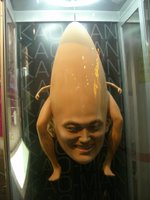
Sited On The Way:
- Not really sure what this is, but it seems to be a Cone-Heads prop gone badly awry!
- my hand in a dryer in the Men's Room [below]. You just stick your hand in and a warm blast of hot air dries them nicely in about 15 secon
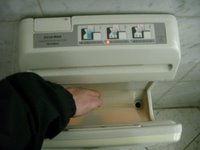 ds. As a bonus, they throw in an untraviolet light beam to kill any nasty germs that might be present. So civilized and sanitary, too; we need this!
ds. As a bonus, they throw in an untraviolet light beam to kill any nasty germs that might be present. So civilized and sanitary, too; we need this!
- I have been wondering
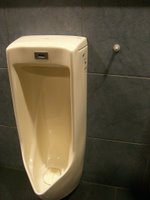 what the little peg (on the right) beside the urinals is for. Close inspection has finally yielded the answer! Why, to hang up your umbrella, of course!
what the little peg (on the right) beside the urinals is for. Close inspection has finally yielded the answer! Why, to hang up your umbrella, of course!
- Della, Jay, Sandra, Jean and myself saying 'Kampai' [Cheers], while waiting for our Okonomiyaki to cook. (think egg omlette collides with a truck carrying fish flakes, cabbage, onions, noodles and raw seafood, and the resulting mess gets flatte
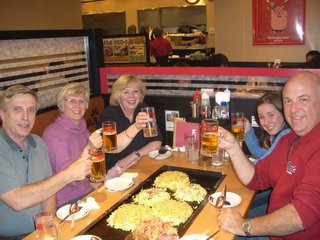 ned into a pancake and then goes up in flames. Meanwhile, at the end they get doused with gravy and maoyonnaise to put the whole thing out!) Oishii
ned into a pancake and then goes up in flames. Meanwhile, at the end they get doused with gravy and maoyonnaise to put the whole thing out!) Oishii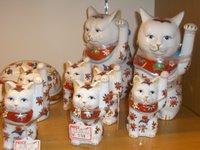 !
!
Doug-san in Japan
saying Sayonara for now!!
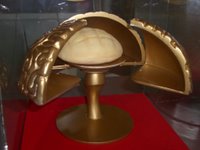

0 Comments:
Post a Comment
<< Home